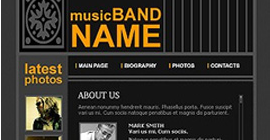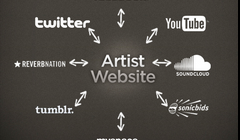Some PRs will tell you – probably rightly – that you can place too much importance on the good old press release when contacting journalists, editors and DJs. A personalised email or sneaky phone call to an existing trusted contact will usually achieve so much more.
Though with hundreds of writers, editors and bloggers out there, inevitably sometimes you are going to want to send out a press release to your whole database, and even when you have a productive phone conversation with a media contact, they are probably going to want key information in writing.
Most of the press releases we receive make a number of big mistakes, all of which can damage your chances of getting coverage. So, here’s some basic tips to make sure you don’t fall into the common traps.
1. Get to the point, fast.
Before you write your press release, ask yourself “what is the news story here?” Why is what you are press releasing newsworthy today, and not yesterday or tomorrow? And make sure this is bleedin obvious in the subject line of the email, and the strapline and first paragraph of the actual release.
This is especially important if you are looking for news coverage, obviously. But even if your release is seeking review or feature coverage, be clear about what is new about your product, person or company at the outset.
You can give your release a snappy slightly ambiguous headline if you like, but the strapline and first paragraph should be factual and to the point. And use an edited version of your strapline, not the ambiguous headline, or generic titles like ‘Press Release’, as your email subject line. Most journalists will only open a fraction of the press release emails they receive – many more releases will go unread than read – and whether yours is opened depends on your email subject line.
Pretty much the entire news story you are telling should be covered in the first paragraph of the release, with perhaps a second paragraph of directly relevant background information. Be a tabloid journalist, and try to make sure you cover the six questions words – what, when, where, who, why, how? – in that first paragraph (well, the ones that are relevant anyway).
2. Adopt a neutral style.
This really bugs music journalists – avoid hyperbole like “best thing since the Beatles” or “the new Pink Floyd”. Keep the OTT adjectives to the minimum and make any descriptions of your product or service or event or company as factual as possible.
Verified stats and achievements are acceptable, so “fastest selling”, “award winning” and so on, albeit in moderation. But claims that are less tangible – “best ever” or “most exciting” or “most innovative” – should be avoided or, if they are required by a client, put in the named quote where they are clearly one person’s opinion. Which brings me to…
3. Include a named quote.
Never send out a press release without a quote credited to someone involved with the project or organisation. You wouldn’t believe how much more likely your press release is to be used as a news story if only you provide a good sizeable quote. Even if you are really looking for reviews, a good news story is actually likely to be seen by more people if you’re targeting online media, and on a quiet news day your review press release might be turned into a news story if it includes a great quote from the artist, A&R, MD, producer or someone else involved in the project.
Review press releases can also include testimonial quotes from third parties talking up your product – though keep these punchy (but not so punchy that it looks like you took the one positive adjective out of a negative review) and credit both the journalist and the publication (if you know both).
4. Present lists as a list (not a table, and avoid tabs if possible).
First up, don’t provide a paragraph of prose running through your list of facts with description and comment. The journalist will write the prose, and they need quick, easy access to the full list of facts to make that possible. Some publications may also publish your list in full as you provided it, hence why tables and tabs are a no-go – think, how easy is it for the journalist to cut and paste my facts into their Word file or content management system?
5. Push anything but the core information to the end – what old school PRs call the ‘notes for editors’ section.
Background information – biogs, product information, useful stats – are all good, and may be used by journalists to flesh out their article, but put this is a separate section at the bottom of the release, after the quote and contact information. Make notes to editors like a Wikipedia entry, all bullet points and short sentences.
6. Always include a photo (or maybe a link to one).
A photo of your product, or any people involved, or the person you’ve quoted, or your logo, or preferably all of these, should be available. Don’t send much more than a mega-byte worth of photos attached to an email, but you can provide links to a web page where lots of photos are available.Don’t forget to check our tips on press photos here.
7. Keep layout simple and image-lite.
Journalists like words and stories, that’s their trade. Nice pictures and layout never ever sold a news story to me, and pretty much every journalist I’ve ever spoken to has concurred on this (fashion and art journalists maybe the exception). Spending hours (or even minutes) inserting logos and images and complicated layout is a total waste of your time, and can actually be counterproductive. The exception here is if you are sending printed press releases with review CDs, in which case decent layout can help.
8. Think about what format you’ll provide it in – NOT PDF!
This links in with seven, keep it simple. I’d include the release as text in the body of an email, and attach it as a Word file, and let the journalists choose which they’d rather use. Never send it as a PDF. If I am going to write about your product I want to cut and paste your words into my file as source material for my article. Cutting and pasting from a PDF, especially one with lots of layout and pictures, is a nightmare. I routinely kick things off my always-longer-than-it-needs-to-be news story list because the source press release is a PDF.
9. Always include a date, and make any embargo very clear.
Best practice is that you always include the date the press release was issued at the top of the page, so the journalist knows exactly when the facts contained within are newsworthy.
The exception to this rule might be a product release which contains the all important date that the product first goes on sale, so that there is no confusion between the date the release is issued, and the date the product is released (it doesn’t help that we call both those things the ‘release date’!). Whatever, make dates very clear.
As for embargoes – requesting the journalist doesn’t write about something until a prescribed time – preferably don’t use them. But if you have to, make sure the line that states the embargo at the top is freaking huge. And then resend the release once the embargo has passed with the embargo line removed.
10. Make sure contact information is correct.
This is stating the bleeding obvious, but you’d be surprised is an issue. Also, the day you send out the release, don’t then have everybody who knows anything about the project out of the office for 48 hours. And don’t have an out of office reply that tells me to speak to someone else who is also out of the office. It’s happened!
Via CMU






